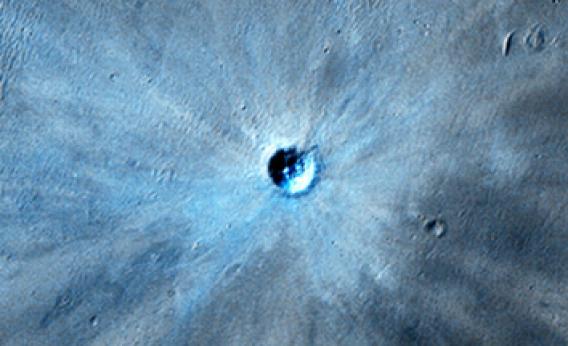Create a free profile to get unlimited access to exclusive videos, sweepstakes, and more!
An Asteroid Impacted Mars, and Did This

Mars sits on the inner edge of the asteroid belt, which means it gets hit by rocks more often than Earth does. Not only that, its thinner atmosphere allows smaller asteroids to make it all the way to the ground, so even something the size of a basketball can slam into the surface intact. This probably happens a few times a month on the Red Planet.
That means new craters are excavated by impacts all the time on Mars! The result? Well, see for yourself:
Bang! That is one of the newest craters on Mars: It’s about 30 meters (100 feet) across, and formed by the explosive impact of an asteroid no more than four years ago. We know that because it wasn’t there in an image of Mars taken by the Mars Reconnaissance Orbiter spacecraft in July 2010, but it was in one taken in May 2012.
How big was the rock that did this, and how big was the resulting kaboom? Well, I can guess. In my TV show Bad Universe we detonated 7,500 pounds of ANFO (ammonium nitrate fuel oil mix)—the explosive equivalent of 1.5 tons of TNT—in the Arizona desert to simulate an asteroid impact. The crater we blasted out of the sand was about 20 meters across. The relationship between the size of an explosion and the size of the crater it leaves behind is complicated, but it’s safe to say that the explosive impact on Mars to form this new crater was at least twice as large as the one we set off, or three tons of TNT.
We figured the size of an impactor needed to make a 20 meter crater on Earth is about that of a beach ball: half a meter or so across. That means the asteroid that hit Mars was bigger. There are lots of other variables—impact speed, composition of the asteroid, composition of the surface, and so on—but it all adds up to something probably in the one-meter range. Say the size of an easy chair.
Mind you, the asteroid itself isn’t explosive like a bomb, but it’s moving at high speed, many times faster than a rifle bullet. That gives it a lot of energy, and that energy is released all at once during impact, making what is to all intents and purposes an explosion. It blows out a huge hole in the ground, ejecting material in all directions. Much of it is laid down as a blanket around the crater, and some in long, narrow rays that you can see clearly in the image. Scientists report that some material reached a distance of more than 15 kilometers (more than 9 miles) from the impact site!
An asteroid this size would almost certainly not make it to the ground on Earth because our much thicker atmosphere would tear it apart on its way in. The huge pressures involved would shred the rock into smaller and smaller pieces while it was still dozens of kilometers above the ground (and that would still likely happen even for an iron asteroid).
But bigger rocks are out there; we’re approaching the first anniversary of one 19 meters (more than 60 feet) across that blew up over Russia. While relatively rare, asteroid impacts are a real threat, and this fresh scar carved into the Martian surface is a stark reminder of that.


























